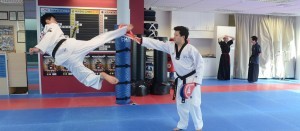TAEKWONDO
 Taekwondo is “the art of kicking and punching.” Tae means “to kick”, Kwon means “to punch” and Do means “art”. However, this is only a superficial translation. ‘Do’ in Korean implies a philosophical viewpoint or way of approaching life – a means by which enlightenment is achieved. This is the ultimate aim of TaeKwonDo. Through vigorous physical training students of the art seek to improve themselves physically, mentally and spiritually.
Taekwondo is “the art of kicking and punching.” Tae means “to kick”, Kwon means “to punch” and Do means “art”. However, this is only a superficial translation. ‘Do’ in Korean implies a philosophical viewpoint or way of approaching life – a means by which enlightenment is achieved. This is the ultimate aim of TaeKwonDo. Through vigorous physical training students of the art seek to improve themselves physically, mentally and spiritually.
TaeKwonDo as an art is practiced in more than 180 countries. It is generally regarded as the most popular of the martial arts. A testament to its growing prominence as both a system of self-defence and a sports attraction was its inclusion in the Olympic Games as an Olympic sport.
The Philosophy of the Belt System
World Taekwondo Federation has standardised the progression of belts and now recognizes five colours below black belt: white, yellow, green, blue and red.
Beginner students wear a white belt. The lack of colour symbolizes purity and innocence as reflected by their lack of knowledge of Taekwondo.
The next belt is yellow, symbolizing the rising sun, which is the source of all life.
The next belt is green, the colour of growing things well rooted and reaching upward toward the sky. At this level students are beginning to develop power.
Next is blue, the colour of the sky, open and boundless, toward which growing things are reaching.
The last colour before black is red, the colour of blood, and the vital essence of life.
Students at this level are deepening their power and control. Finally, there is black belt. Black represents all of the colours combined. At this highest stage the mastery of techniques is reflected by calmness, dignity and sincerity.
Click to join our classes NOW!!
TAEKWONDO Poomsae
 More than any other exercise or drill, the practice of forms is the most important element in the development of proper TaeKwonDo technique. Required for advancement at level from beginner through master, forms serve a multidimensional role, aiding in breath control and rhythm, all of which are essential skills to the TaeKwon Do student.
More than any other exercise or drill, the practice of forms is the most important element in the development of proper TaeKwonDo technique. Required for advancement at level from beginner through master, forms serve a multidimensional role, aiding in breath control and rhythm, all of which are essential skills to the TaeKwon Do student.
Students are taught one form at each successive belt level, beginning with the white belt level (which indicates a novice student). When a student has mastered the specific form for his/her belt level and has demonstrated an increased proficiency with the basic techniques, he/she is ready to advance to the next level.
TAEKWONDO Competition Sparring
Every student enjoys the challenge and excitement of sparring. It is the best way for students to test their practical fighting ability. Historically, however, the problem with sparring has been to balance a realistic fighting situation against safety. If student were allowed to punch and kick at each other without restraint, serious injuries would result. To prevent this, different martial art systems have developed various restrictions on sparring.
TaeKwonDo takes a moderate position with respect to sparring rules. While contact sparring is a regular part of training and competition, there are certain restrictions. By requiring competitors to wear protective padding and restricting attacks to the front of the body and the head, students are protected from serious injury.
Before students are allowed to begin sparring, certain fundamental techniques must be mastered. These techniques allow students to make a smooth transition from the more rigid movements of simple drills to the fluid motions of a competitive fighter. In any sparring situation it is essential that the student be able to move quickly and effectively around the ring. When a student learns to do this properly he/she is able to manipulate the opponent into revealing momentary openings that may be exploited, and to respond effectively to any movements or changes in stance by the opponent. On the other hand, if a student does not learn to move correctly, chances are good that he’ll/she’ll be an ineffective competitor in the ring.
The best techniques in the world will not help the student if they cannot get close enough to his opponent to use them, or if they cannot move out of the way of an attack launched by the opponent.
